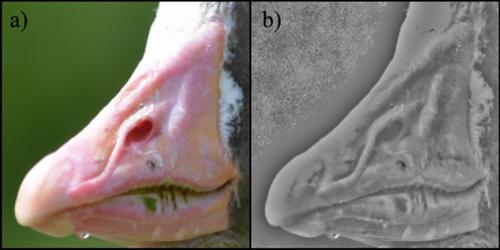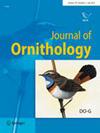Cues to individuality in Greylag Goose faces: algorithmic discrimination and behavioral field tests
IF 1.3
4区 生物学
Q2 Agricultural and Biological Sciences
引用次数: 0
Abstract
Abstract Cues to individuality, and the corresponding capacity for individual-level discrimination, can allow individually specific investment by conspecifics into offspring, partners, neighbors or competitors. Here we investigated possible cues to individuality via faces in an ancient avian lineage, the Greylag Goose ( Anser anser ). Konrad Lorenz could famously name each Greylag Goose in ‘his’ flock from a photograph. Confirming this anecdotal observation, we developed facial recognition software that can reliably (~ 97% accuracy) assign a goose face to a goose ID within a database, using bill morphology normalized during photo preparation. To explore conspecific detection of individuality cues, we erected life-size photos of geese and measured subjects’ responses to photos of themselves (unfamiliar goose), their partner, and another flock mate. Geese displayed significantly greater affiliative response to photos of their partners, providing evidence that geese can use two-dimensional images as cues to determine social category (partner/non-partner) and/or individual-level recognition. Our methods provide novel approaches to automatically detect and monitor geese and to test avian cognition. Our approach may also create new opportunities for species monitoring approaches more generally using photographic images and citizen-science engagement.

灰雁面部的个性线索:算法歧视和行为现场测试
个体特征线索和相应的个体层面歧视能力,可以允许个体对后代、伴侣、邻居或竞争对手进行个体特异性投资。在这里,我们研究了一种古老的鸟类谱系——灰雁(Anser Anser)——通过面部可能的个性线索。康拉德·洛伦兹可以根据照片说出“他”群中每只灰雁的名字。为了证实这一观察结果,我们开发了面部识别软件,该软件可以可靠地(约97%的准确率)将鹅脸分配给数据库中的鹅ID,使用在照片准备过程中规范化的喙形态。为了探索个性线索的同构检测,我们建立了鹅的真人大小的照片,并测量了受试者对他们自己(不熟悉的鹅),他们的伴侣和另一个群体的伴侣的照片的反应。大雁对其伴侣的照片表现出更强的依恋反应,这证明大雁可以使用二维图像作为线索来确定社会类别(伴侣/非伴侣)和/或个人层面的识别。我们的方法为自动检测和监测鹅以及测试鸟类认知提供了新的方法。我们的方法也可能为更广泛地使用摄影图像和公民科学参与的物种监测方法创造新的机会。
本文章由计算机程序翻译,如有差异,请以英文原文为准。
求助全文
约1分钟内获得全文
求助全文
来源期刊

Journal of Ornithology
生物-鸟类学
自引率
7.70%
发文量
0
审稿时长
3-8 weeks
期刊介绍:
The Journal of Ornithology (formerly Journal für Ornithologie) is the official journal of the German Ornithologists'' Society (http://www.do-g.de/ ) and has been the Society´s periodical since 1853, making it the oldest still existing ornithological journal worldwide.
 求助内容:
求助内容: 应助结果提醒方式:
应助结果提醒方式:


